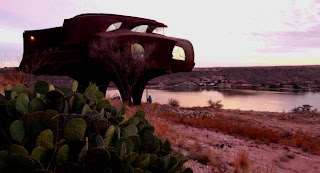


I mentioned that Mr. Bob Bruno was the real “Iron Man” in one of my recent newsletters (June 2008) Click Here to read the newsletter article..
In short, Mr. Bruno was an architectural instructor at Texas Tech University while I was attending architecture school there. Also while I was at Tech, he was just getting started on the construction of his now famous welded steel house.
In short, Mr. Bruno was an architectural instructor at Texas Tech University while I was attending architecture school there. Also while I was at Tech, he was just getting started on the construction of his now famous welded steel house.
Unfortunately, the “Iron Man” was not able to fight off cancer and he passed on in December. Below are a couple of articles that tell a little more about him.
You can also learn more from his web site at http://www.robertbruno.com/ and from his 5 min. 31 sec YouTube video at http://www.youtube.com/watch?v=azy-Xxfnxvw .
Robert R. Bruno (born January 30, 1945, Los Angeles, Calif.), internationally recognized sculptor and artist, died Tuesday, December 9 from complications of cancer at Covenant Medical Center in Lubbock.
Robert's 110-ton steel architectural sculpture located in Ransom Canyon is a well known labor of love and artistic expression of 35 years in the making. It has earned international accolades and publicity in art, architecture, and many professional publications, on film and TV events including HGTV's "Extreme Homes" and The Learning Channel. His sculptured home attracts photographers and admirers worldwide. It was the backdrop for the 2007 Fall Neiman Marcus fashion catalog.
Robert taught, guest lectured, and mentored students at Texas Tech's School of Architecture for years and freely shared his philosophy and sculpture with many visitors to the Canyon. He was also recognized for the design and creation of the first solar-powered surge valve and fertigation system for row crops through his Lubbock-based irrigation manufacturing company, P&R Surge Systems. His valve has conserved millions of gallons of water, fuel and fertilizer for row crop irrigators worldwide for over 25 years. "
Here is a great article about his house:
Against Interpretation: Robert Bruno’s house of welded steel conjures up many meanings, but it arose without any of them
AIArchitect November 2007
For 33 years, Robert Bruno has meticulously designed and built his welded steel house on the edge of a canyon outside of Lubbock, Tex. But, somehow, he’s not sure how many square feet it is (his guess is 2,700) and he can’t explain the influences that have informed his design over these three decades—despite the fact that the house’s otherworldly shape seems tailor-made for free association. A brief jaunt through any design-oriented mind brings you to: an insect’s carapace, an alien spacecraft, M.C. Escher’s hallucinogenic maze-scapes, and perhaps Deconstruction’s ongoing War on the Rectangle. But Bruno isn’t an entomologist, a science fiction writer, or even a Koolhaas/Gehry acolyte. He’s an artist, and not a conceptual one. “This house doesn’t deal with concept at all,” he says. “I’m not trying to have something re-emerge in the guise of my house.”
The house hitches itself to no stylistic wagons and has been spontaneously designed and revised over the course of its 33-year construction. “What you’re seeing is 33 years of design, not three months of design and 33 years of labor,” Bruno says. If he would have had to design the house in full initially and then build to this exact standard, “I would feel as if I were working for somebody else,” he says. This is a literal distinction for Bruno. He began the house when he was a young man, age 29. Today he’s 62, and the majority of his years have been spent working on the house; an open film exposure documenting his aesthetic development and intent.
Bruno says this type of spontaneous, whimsical design is what creates the aesthetic complexity people crave, missing from most of the built environment around us, and largely absent from the practice of architecture itself. “It isn’t that we’re looking for the silliness of a maze,” he says.
“We’re looking at a higher order of complexity.” The crux of the problem: Market realities demand that architects communicate to clients what a project will be before it exists through imperfect, distorting mediums like models. From this point on, Bruno says the scale is manipulated and details are whitewashed in the transition. “Inadvertently, what ends up happening is that the resolution at the model level is potentially quite different from what you would resolve at full scale. I would venture to say that almost all the large buildings we see around us are the replica and the original is the model,” he says."